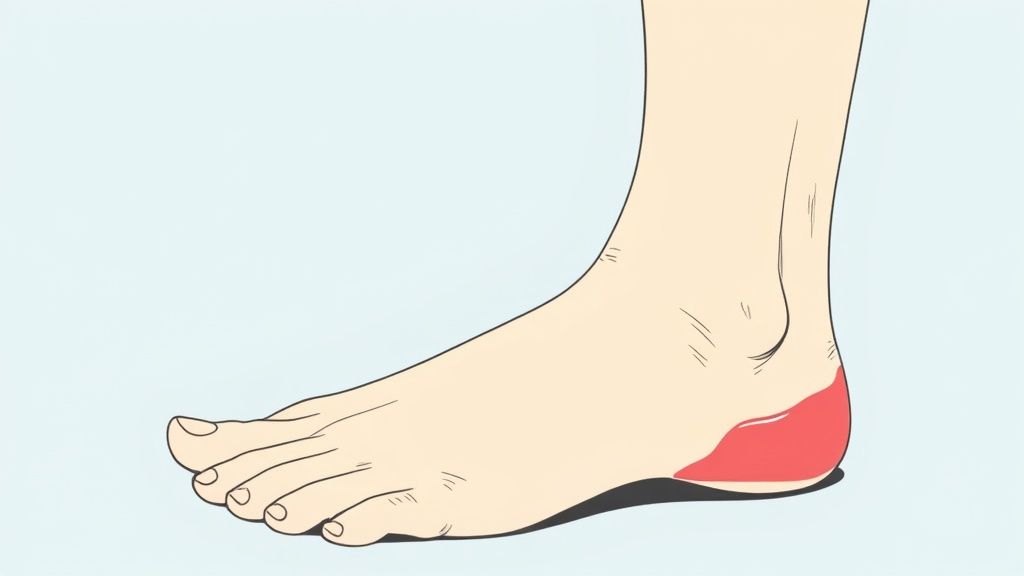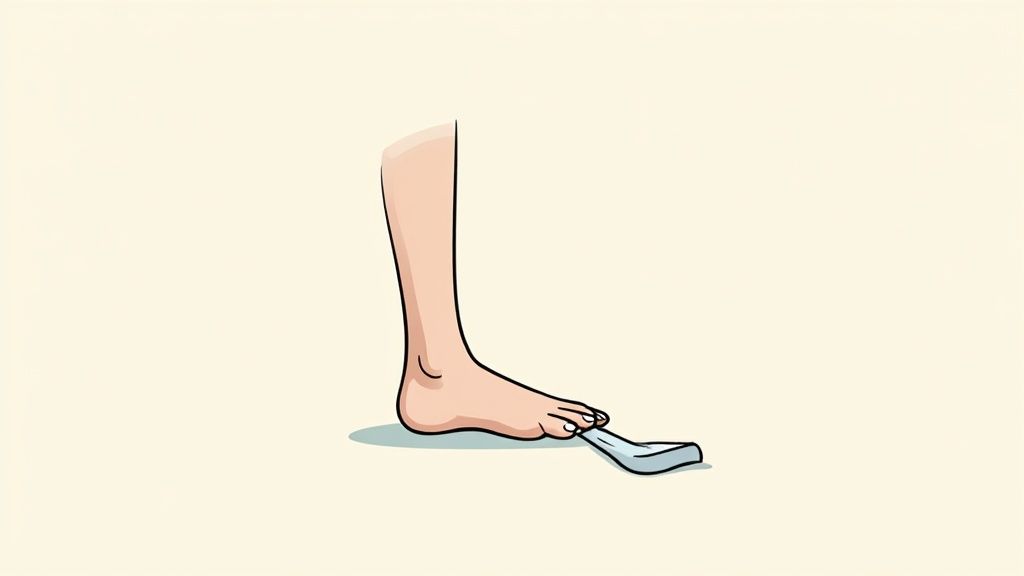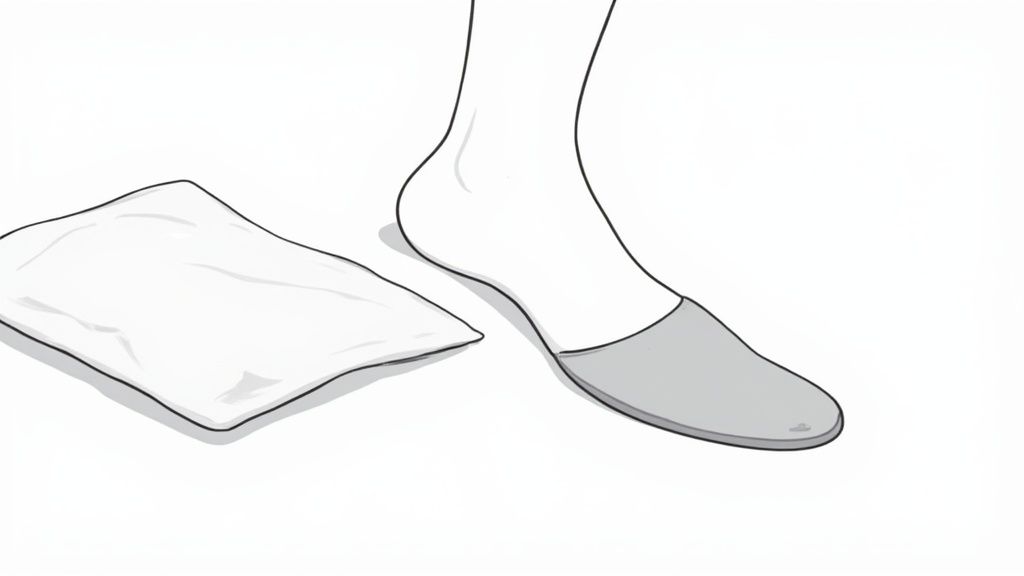If you're asking yourself, "what kind of doctor treats plantar fasciitis?", the answer is simpler than you might think. Your first stop should almost always be your Primary Care Physician (PCP), or family doctor. They are your best starting point for getting an initial diagnosis, trying out some first-line treatments, and acting as your healthcare quarterback.
Finding the Right Doctor for Your Heel Pain

When that sharp, stabbing pain hits your heel first thing in the morning, it's natural to think you need a specialist right away. But hold on—your trusted family doctor is actually the perfect person to see first. Think of them as the gatekeeper for your health; they have a wide range of knowledge and are well-equipped to handle common problems like this.
Plantar fasciitis is incredibly common. In fact, it's responsible for about 1 million patient visits per year in the United States. A huge chunk of those—roughly 60%—are handled by primary care doctors, which shows just how central they are in treating this condition. You can dig into more of the data on plantar fasciitis visits on aafp.org.
Your First Consultation
When you see your PCP, they'll start with a physical exam. They'll ask you about your symptoms—like if the pain is worst when you get out of bed—and gently press on different spots on your foot to find the source of the tenderness. For most people, this simple, hands-on check is all it takes to confirm a diagnosis.
One of the biggest benefits of seeing your PCP first is that they can usually diagnose plantar fasciitis based on your story and a physical exam alone. This means you can often skip expensive or time-consuming imaging tests like X-rays or MRIs, at least initially.
This straightforward approach gets you on the path to relief much faster.
Initial Treatment and Referrals
Once you have a diagnosis, your PCP will lay out a conservative treatment plan. This almost always starts with the basics:
- Rest: Taking a break from activities that aggravate your heel.
- Stretching: Simple exercises for your calf and foot to loosen things up.
- Pain Relief: Using over-the-counter anti-inflammatories to ease discomfort.
- Support: Recommending more supportive shoes or basic shoe inserts.
For many people, these simple steps are enough to make a real difference. But if your pain just won't quit or it's particularly severe, your PCP won't leave you hanging. They'll know exactly when it's time to bring in a specialist—like a podiatrist or physical therapist—and will make sure your care journey is seamless and effective.
Here's a quick look at the different professionals who might be part of your plantar fasciitis treatment team.
Your Plantar Fasciitis Healthcare Team
This table gives a quick overview of the different medical professionals who can help manage and treat your heel pain.
| Healthcare Provider | Role in Your Treatment | When to See Them |
|---|---|---|
| Primary Care Physician (PCP) | Your first point of contact. Diagnoses the issue, provides initial conservative care, and coordinates referrals. | Start here. See your PCP as soon as you experience persistent heel pain. |
| Podiatrist | A foot and ankle specialist. Offers advanced diagnostics and treatments like custom orthotics and injections. | If your pain doesn't improve after 4-6 weeks of initial care with your PCP. |
| Physical Therapist (PT) | A movement expert. Creates a personalized exercise and stretching plan to address the root mechanical cause of the pain. | Often recommended by your PCP or podiatrist. Great for long-term recovery and prevention. |
| Orthopedic Surgeon | A specialist in musculoskeletal conditions. Focuses on surgical solutions for severe, chronic cases. | As a last resort, if all other non-surgical treatments have failed after 6-12 months. |
Navigating healthcare can feel complicated, but for plantar fasciitis, the path usually starts with a simple visit to your family doctor.
What’s Really Causing That Pain in Your Heel?

Before you can find the right treatment, it helps to know exactly what’s happening inside your foot. Picture a thick, tough ligament running along the bottom of your foot, almost like a bowstring. This is your plantar fascia, and its job is to connect your heel to your toes and support your arch, absorbing the shock of everyday life.
But what happens when you stretch a rubber band too much, too often? It starts to fray and lose its snap. Your plantar fascia is no different. When it’s put under too much stress, it gets irritated, angry, and inflamed. That inflammation is plantar fasciitis, and it’s the source of that sharp, stabbing pain you feel.
That awful pain with your first steps out of bed is the classic calling card of plantar fasciitis. Why? Because the fascia tightens up overnight. When you suddenly put your weight on it, that tight tissue gets a rude awakening, causing that signature jolt of pain.
Knowing the Key Symptoms
Being able to clearly describe what you're feeling is the first step toward getting the right help. It's not just about morning pain; there are a few other clues that point directly to plantar fasciitis.
- Pain after you’ve been off your feet: The pain doesn't just show up in the morning. It often flares up after you've been sitting at your desk or resting on the couch for a while.
- Pain that fades as you move: For a lot of people, the worst of the pain actually subsides after a few minutes of walking. As the fascia warms up and stretches out, things start to feel a bit better.
- Pain that comes back after exercise: You might feel fine during your run or workout, but the pain often comes roaring back once you cool down and rest.
Understanding these patterns is a game-changer. It helps you have a much more productive conversation with a specialist and gives you confidence that you’re on the right track. This is an incredibly common issue, affecting millions of people.
Getting to the bottom of what caused your specific case—whether it’s your foot shape, your job, or your shoes—is crucial for recovery. To dig a little deeper, it's worth learning more about how you get plantar fasciitis and the factors that put you at risk. When you understand the "why," you and your doctor can create a much smarter plan to fix it for good.
When to See a Podiatrist for Specialized Care

So, you've been following your primary doctor's advice, stretching, and icing, but that stabbing heel pain just isn't getting any better. This is usually the point where it’s time to call in a specialist. A podiatrist, or foot doctor, is the expert you want on your team when it comes to conditions of the foot and ankle.
Think of them as the next level of care. When the initial game plan from your family doctor isn't cutting it, a podiatrist has the specialized training and deep understanding of foot biomechanics to tackle stubborn cases of plantar fasciitis.
Signs It's Time to See a Podiatrist
How do you know it's officially time to make that appointment? Your body will usually give you some pretty clear signals. Here's what to watch for:
- Persistent Pain: The pain has dragged on for several weeks or even months with little to no improvement.
- Recurring Flare-Ups: You get some relief, but the pain just keeps coming back and disrupting your life.
- Severe Symptoms: The pain is so intense that it makes walking difficult or stops you from doing your normal daily activities.
- Complicating Factors: You have another health issue like diabetes, arthritis, or flat feet that could be making things worse.
When foot pain goes from being a nuisance to a chronic problem, a podiatrist can offer a fresh perspective. They have the tools and experience to figure out why your condition isn't healing and what to do about it.
Advanced Treatments a Podiatrist Offers
A podiatrist has a whole toolkit of advanced solutions for persistent plantar fasciitis. They'll start with a thorough exam, sometimes using imaging tests to make sure nothing else is going on, and then create a more targeted treatment plan.
One of their most powerful tools is custom orthotics. Forget the one-size-fits-all inserts from the drugstore; these are molded specifically to the unique shape of your feet. By correcting your specific biomechanical issues, they provide tailored support right where you need it, which can be a total game-changer for long-term relief.
If the inflammation is particularly bad, a podiatrist might suggest corticosteroid injections. This involves injecting a powerful anti-inflammatory medication directly into the most painful area to quickly calm things down. They can also introduce you to other options like shockwave therapy. For a full rundown of potential treatments, you can read more about what to do for plantar fasciitis and see how a specialist can guide you.
The Physical Therapist's Role in Your Recovery

Getting rid of the pain is the first step, but keeping it from coming back is the real win. This is where a Physical Therapist (PT) becomes your most valuable ally. While other specialists zero in on the immediate injury, a PT is more like a movement detective. They dig deep to find and fix the underlying biomechanical issues that led to the pain in the first place.
Think of it like this: a podiatrist puts out the fire, while a PT fireproofs the entire building. They aren't just treating the symptom; they're addressing the root cause. This focus on long-term prevention is what helps you get back to your life without constantly worrying about another flare-up.
Your Personalized Roadmap to Recovery
Working with a physical therapist means you get a plan built just for you. Their goal is to improve how your body moves from the ground up, making sure your feet are strong enough to handle the stresses of your day-to-day life.
A solid physical therapy plan usually involves a few key things:
- Targeted Stretches: You'll learn gentle, specific stretches designed to lengthen the tight plantar fascia and calf muscles. These are often the main culprits behind the pain.
- Strengthening Exercises: The plan will include exercises to build up the small muscles inside your feet and lower legs. Stronger muscles mean better arch support and shock absorption.
- Manual Therapy: This is where the therapist gets hands-on. They use special techniques to work on the soft tissues and joints in your foot, which can dramatically improve flexibility and ease pain.
A PT provides a personalized roadmap to not only heal your current injury but also to prevent it from derailing you in the future. Their hands-on guidance and education empower you to take control of your recovery.
Effective treatment for plantar fasciitis almost always involves a mix of different strategies. Around the world, the best approaches combine professional care with things you can do at home. Taping, stretching, and personalized education are central to managing heel pain for good. You can discover more about these combined treatment approaches on bjgp.org.
Other Specialists Who Treat Persistent Heel Pain
For a small handful of people, that stabbing heel pain just won't quit. When plantar fasciitis decides to stick around for months, resisting all the usual treatments, it’s time to call in the specialists. Knowing who to see next is crucial when you're dealing with a case that just won't budge.
If your pain isn't improving and it's really getting in the way of your life, your podiatrist might suggest you see a Sports Medicine Doctor. These physicians are experts in how the body moves, making them a fantastic resource, especially for athletes or anyone with a very active lifestyle. They excel at diagnosing and treating injuries caused by repetitive stress.
The Last Resort Surgical Option
What happens when you've tried everything for six to twelve months and nothing has worked? This is when an Orthopedic Surgeon might enter the picture. These are the surgeons who specialize in the entire musculoskeletal system—bones, joints, ligaments, you name it.
It's really important to know that surgery is never the first, second, or even third option. An orthopedic surgeon will only talk about a procedure, like a plantar fascia release, after you've exhausted every single conservative treatment out there. The surgery itself involves carefully cutting a small part of the plantar fascia ligament to relieve the intense tension.
The decision to go under the knife is a big one, and it's reserved for less than 5% of patients. This really drives home how effective the simpler, non-surgical treatments are for the vast majority of people. Sticking with your initial care plan is almost always the key to recovery.
Even if you have one of the most stubborn cases of plantar fasciitis, there are always more experts and more options available to get you back on your feet. For a deeper look at all the different approaches, our guide on how to treat a plantar fasciitis covers the full range of options.
Answering Your Questions About Plantar Fasciitis Treatment
Dealing with plantar fasciitis brings up more than just medical questions—you've got practical concerns, too. It helps to understand the logistics of getting care, what to expect for recovery time, and what other therapies might help. Getting these answers upfront can give you confidence as you work your way back to pain-free feet.
If you're dealing with this, you're not alone. Plantar fasciitis is surprisingly common. In the U.S., about 0.85% of people have been diagnosed with it. It's especially common in women—they are 2.5 times more likely to have it than men—and the chances increase as we get older. For a deeper dive, you can check out the full analysis of plantar fasciitis prevalence from the NCCIH.
Do I Need a Referral to See a Podiatrist?
This is a classic "it depends" situation, and what it depends on is your health insurance.
If you're on a PPO plan, you can usually just pick up the phone and make an appointment directly with a specialist like a podiatrist. But if you have an HMO, you'll almost always need to see your primary care doctor first to get a referral.
The best way to know for sure? Just call the member services number on the back of your insurance card. A quick five-minute call can clear things up and save you from a surprise bill down the road.
How Long Does Plantar Fasciitis Take to Heal?
Everyone’s recovery journey is a little different. Many people start feeling much better within a few months, especially if they stick to the basics: consistent stretching, wearing supportive shoes, and taking a break from activities that make the pain worse.
But let's be honest—plantar fasciitis can be incredibly stubborn. For some, it can be a long haul, taking anywhere from six to twelve months to fully go away. The key is to be diligent. Following the advice from your doctor and physical therapist is your best bet for speeding things up.
Since plantar fasciitis is a classic overuse issue, learning about preventing repetitive strain injuries can also give you some great strategies to keep it from coming back.
Can a Chiropractor Help With Plantar Fasciitis?
Some people absolutely find relief with chiropractic care. A chiropractor might use adjustments on your foot, ankle, or even your spine to correct any alignment issues. They also use soft tissue work to ease the tension that might be contributing to the strain on your plantar fascia.
While your family doctor or a podiatrist is usually the first stop, don't rule out chiropractic care. It can be a really helpful part of your overall treatment plan, working alongside other therapies to get you back on your feet.
Don't let foot pain run your life. Samurai Insoles were designed by a podiatrist to give your feet the springy, biomedical support they need to fight overpronation and ease the ache of plantar fasciitis. Find the right insole for you and get started on your path to relief at https://samuraiinsoles.com.



